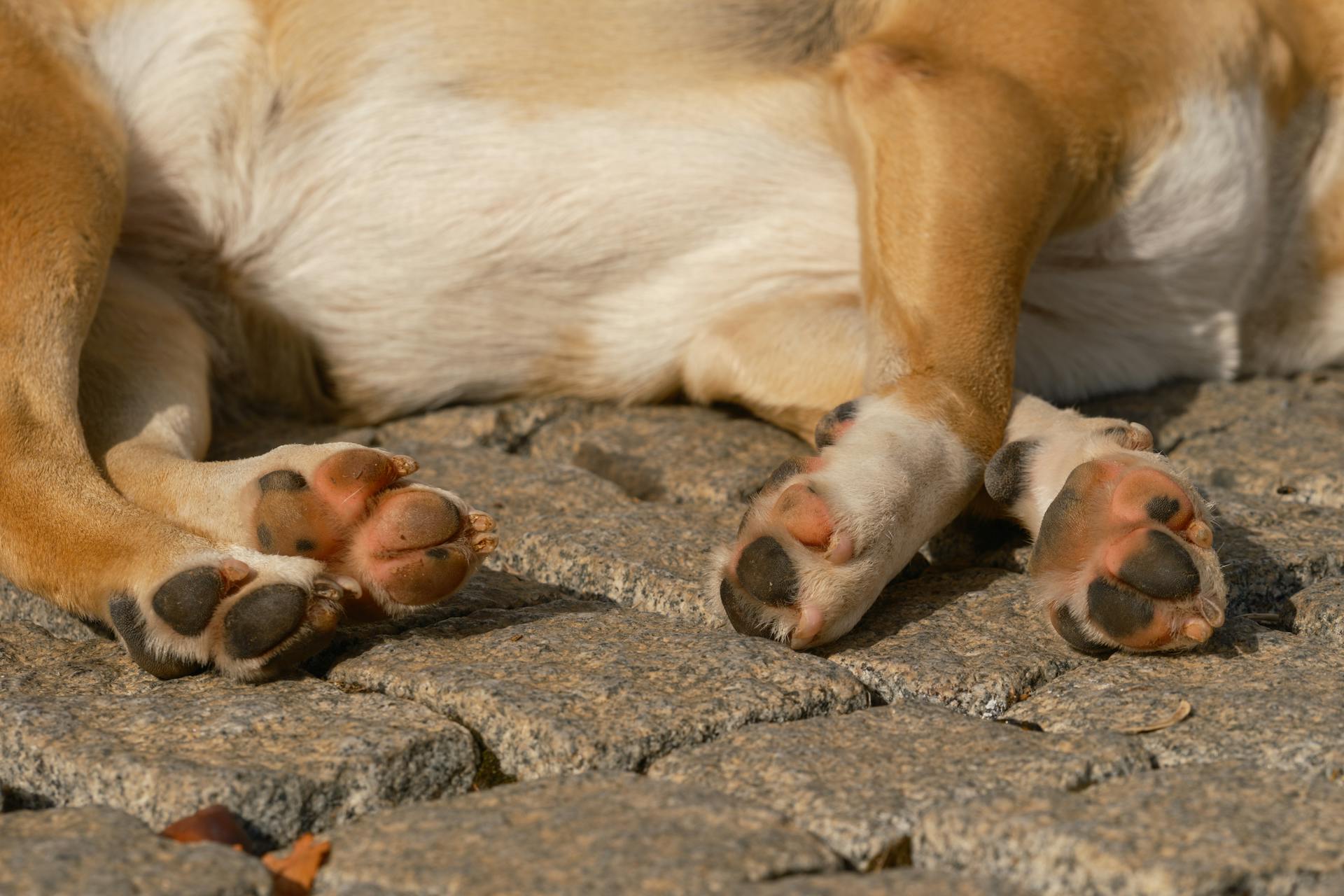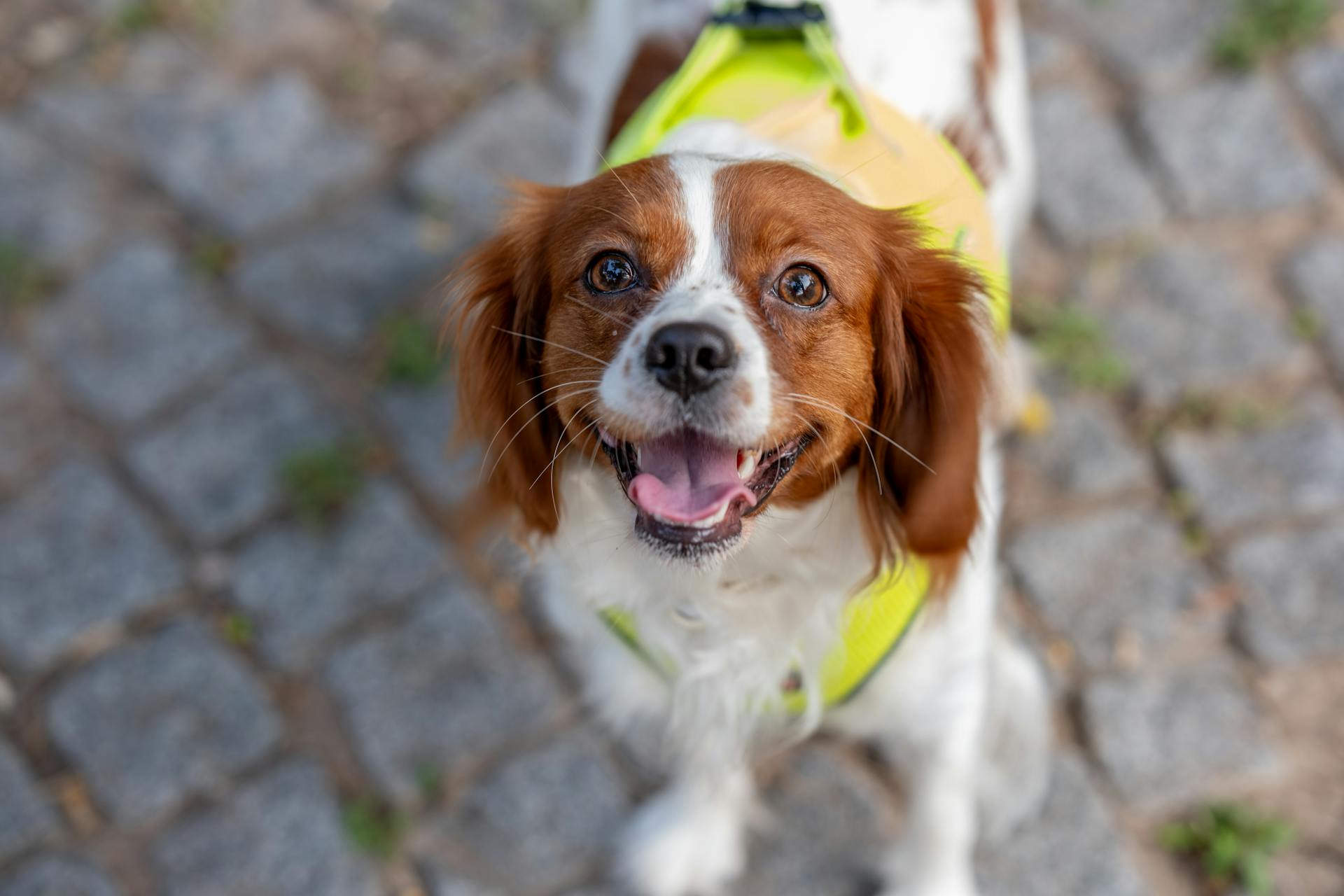
The dog's eye is a remarkable organ, and understanding its anatomy can help us appreciate its complexity. The eye is made up of several layers, including the cornea, sclera, and retina.
The cornea is the transparent outer layer of the eye, responsible for refracting light. It's a bit like the windshield of a car, allowing us to see the world outside.
The sclera, on the other hand, is the white part of the eye, providing protection and structure. It's a bit like the skin on a grape, but instead of being edible, it's a vital part of the eye's anatomy.
The retina is the innermost layer of the eye, responsible for detecting light and sending signals to the brain. It's made up of specialized cells called photoreceptors, which are like tiny little cameras that capture images.
Consider reading: Male Canine Anatomy
Dog Eye Anatomy
The anatomy of a dog's eye is quite fascinating, and it's actually very similar to that of a human eye. Dogs have an upper and lower eyelid, just like people.
One of the key similarities between dog and human eye anatomy is the presence of a sclera, which is a tough, fibrous layer often referred to as the "white" of the eye. This layer provides protection to the eye.
Dogs also have a cornea, which is a thin, clear layer at the front of the eye that can be easily injured. I've seen this happen to my own dog, and it's not a pleasant sight.
Here are some of the key eye structures in dogs, listed out for easy reference:
- Sclera: Tough, fibrous layer that’s often referred to as the “white” of the eye
- Cornea: Thin, clear layer at the front of the eye that can be injured easily
- Iris: Colored part of the eye that contains smooth muscle and controls the size of pupil
- Pupil: Black area in the center of the iris; It contracts (gets smaller) in bright light or dilates (gets bigger) in dim light
- Lens: Located behind the iris; it changes shape to focus light on the retina
- Retina: Located in the back of the eye; it contains photoreceptors called rods, which sense light and movement, and other photoreceptors called cones, which sense colors
Choroid
The choroid is a layer of blood vessels that supplies the retina with oxygen and nutrients. It's a crucial part of the eye's anatomy, playing a vital role in maintaining the health of the retina.
Located between the sclera and retina, the choroid is a thin layer of tissue that's rich in blood vessels. This unique structure allows it to efficiently supply the retina with the oxygen and nutrients it needs to function properly.
Nictitating Membrane
The nictitating membrane, also known as the third eyelid, is a unique feature of a dog's eye anatomy.
It's located at the corner of the eye, near the nose, and is whitish in color. This membrane helps protect the eye from scratches.
The nictitating membrane is composed of a T-shaped cartilage.
When a dog blinks, the third eyelid moves across the eye to help produce tears. This is an essential function to keep the eye moist and healthy.
Here's a comparison of the eye structures that dogs have and those that humans have:
It's fascinating to note that the nictitating membrane is a key adaptation that allows dogs to see better in low light conditions, thanks to the tapetum lucidum.
Entropion
Entropion is a common problem in which the eyelid is turned under so that the lashes rub the cornea, resulting in corneal irritation and ulceration.
This condition is particularly common in breeds such as Rottweilers, Chow Chows, Shar Peis, and English Bulldogs.
The condition can be corrected with surgery that results in a more normal relationship of the eyelid to the cornea.
Abnormally placed eyelashes are also a common problem seen in clinical practice, similar to entropion.
Distichiasis
Distichiasis is a condition where fine hairs grow at the eyelid margin, commonly found in breeds like the Cocker Spaniel.
These hairs are often mistaken for eyelashes, but they're actually a different type of hair altogether.
In most cases, these fine hairs don't cause any issues, but if they're causing discomfort, it's best to have them removed by a professional.
Distichiasis is more common in certain breeds, and it's essential to be aware of it to ensure your furry friend's eye health.
Recommended read: Dog Breeds Watch Dogs
Physical Exam
During a physical exam, your vet will use an ophthalmoscope to shine a bright light and magnify the eye to assess eyesight and internal parts.
This specialized instrument helps identify any problems with your dog's eye. Your vet will also use it to examine the inner part of the eye after dilating the pupils with eye drops.
The Schirmer Tear Test measures tear production in the eye, which is crucial because dry eye can cause corneal scarring and pigmentation that can lead to blindness if left untreated.
A different take: Veteran Dog Treats
Corneal scratches or injuries can be visualized using a drop of fluorescein stain placed onto the eye, a process known as a corneal stain.
Elevated intraocular pressure (IOP) can be a sign of glaucoma, a serious condition that can cause pain and blindness if left untreated.
Here's a quick rundown of the tests your vet may perform during a physical exam:
- Schirmer Tear Test: measures tear production
- Corneal stain: visualizes corneal scratches or injuries
- Intraocular pressure (IOP) test: determines the pressure within the eye
- Dilating the pupils: allows for examination of the inner part of the eye
Dog Eye Colors and Vision
Dogs can have a variety of eye colors, including brown, blue, golden, and hazel.
Brown is the dominant eye color for most dogs.
Dogs can have two different-colored eyes, which often occurs in dogs with a merle coat pattern, or in certain breeds such as Huskies or Australian Shepherds.
Readers also liked: Heterochromia Dog Names
Dog Eye Colors
Dogs can have a variety of eye colors, including brown, blue, golden, and hazel. Brown is the dominant color for most dogs.
The iris pigmentation can vary depending on breed, color of the face, and genetics. This means that different breeds and individual dogs can have unique eye colors.
Dogs with light-colored eyes, such as blue, do not necessarily have vision problems or blindness. Some dogs, like Huskies and Australian Shepherds, can have two different-colored eyes.
For more insights, see: Natural Dog Eye Colors
Can Dogs See Color?
Dogs can see color, but only in shades of blue and yellow. This is because they have dichromatic vision, which means they can only see two colors.
Dogs can also see shades of gray. This is helpful for them to navigate their surroundings.
Colors such as red, orange, and green are out of a dog's color spectrum, so these colors are not visible to dogs. This is why hunters can wear orange to be visible to other hunters but not to animals.
Explore further: Amber Dog Eye Colors
Dog Vision Capabilities
Dogs have worse eyesight than humans in some respects, but better eyesight in others. Their vision is unique and tailored to their environment.
Dogs have more rods in their retina than humans do, making them more sensitive to movement and dim light. This is why they can see moving objects much better than stationary ones.
Dogs can see moving objects 10-20 times better than humans, thanks to their greater motion sensitivity. This is why they're so good at picking up on small changes in body posture and movement.
Intriguing read: Why Do Female Dogs Hump My Male Dog
Dogs have dichromatic vision, meaning they can see only shades of blue and yellow, as well as shades of gray. Colors like red, orange, and green are out of their color spectrum.
Dogs can see in the dark better than humans thanks to several anatomical advantages, including more rods in their retina, larger pupils, a closer lens to the retina, and the tapetum lucidum, which reflects light.
A dog's eyes are spaced slightly farther apart than ours, at a 20-degree angle, increasing their field of view and peripheral vision.
Dog Eye Health and Diagnostics
The cornea is the transparent outer layer of the eye, and it's essential for maintaining clear vision. It's composed of several layers, including the epithelium, stroma, and endothelium.
A dog's eye has a unique anatomy, which can make certain eye problems more challenging to diagnose. The sclera, or white part of the eye, is relatively thin in dogs, making it easier to detect problems.
The conjunctiva is a thin membrane that covers the white part of the eye and the inside of the eyelids. It's rich in blood vessels, which can make it prone to inflammation.
Eye exams are crucial for detecting eye problems early on. A veterinarian can use a tonometer to measure the pressure inside a dog's eye.
Redness, discharge, and squinting are common signs of eye problems in dogs. If you notice any of these symptoms, it's essential to have your dog examined by a veterinarian.
The shape and size of a dog's eye can affect its susceptibility to certain eye problems. Brachycephalic breeds, for example, are more prone to eye problems due to their short, compact skull structure.
Dog Eye Limitations
Dogs have worse eyesight in some respects, but better eyesight in others. Their visual acuity is not as sharp as ours, making it harder for them to see distant objects clearly.
Dogs can only see objects clearly within a certain distance, which is usually around 20 feet. This is because their eyes are designed for close-up vision.
Dogs have a wider field of peripheral vision, allowing them to see more out of the corner of their eye. This helps them detect movement and stay alert to potential threats.
Dogs can detect movement better than humans, thanks to their wide field of peripheral vision and a higher concentration of rods in their retina. This makes them great at catching prey or detecting potential threats.
Dogs have limited color vision, seeing the world in shades of yellow, blue, and gray. They can't see red or green colors like we can.
Dogs can see in low light conditions, thanks to a reflective layer in the back of their eyes called the tapetum lucidum. This helps them navigate and hunt at night.
Frequently Asked Questions
What does a dog eye infection look like?
A dog eye infection can manifest as discharge, redness, swelling, or excessive blinking. If you notice any of these symptoms, it's essential to seek veterinary attention to prevent further complications
What is in the corner of my dogs eye?
Your dog's third eyelid gland is located in the inner corner of their eye, and it helps lubricate the eye by covering it diagonally
Sources
- https://www.dechra.co.uk/companion-animal/ophthalmology/anatomy-of-the-eye
- https://www.safarivet.com/care-topics/dogs-and-cats/eye-disease/
- https://www.petmd.com/dog/general-health/how-do-dogs-see-world
- https://www.dvm360.com/view/ophthalmic-anatomy-and-diagnostics-proceedings
- https://firstvet.com/us/articles/anatomy-and-function-of-your-pets-eyes
Featured Images: pexels.com


